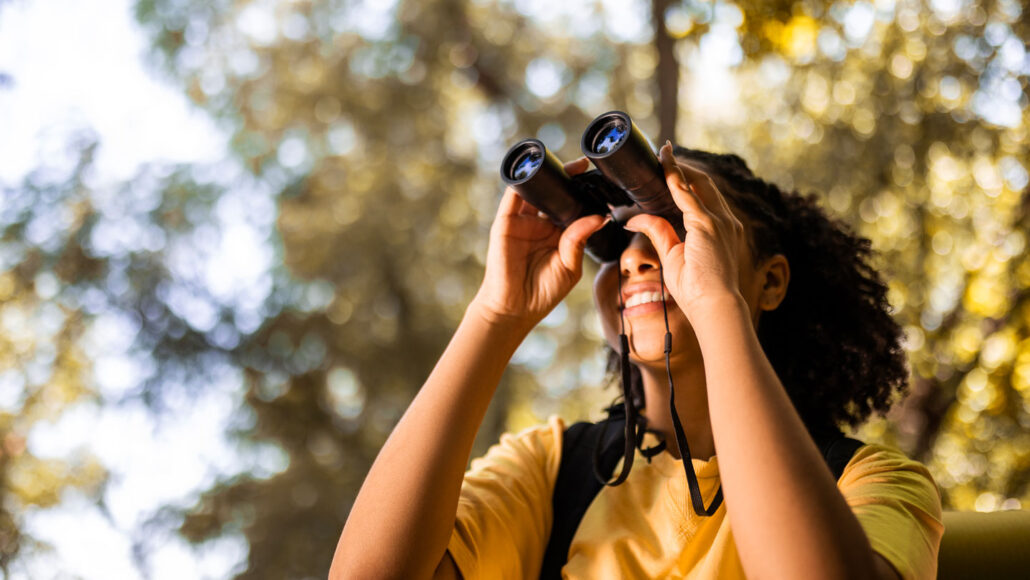Let’s learn about birdwatching for beginners
Birdwatching can be personally and scientifically rewarding. Here’s how to get started

Birdwatching can help you get in touch with local ecosystems and provide scientists with valuable data.
Nastasic/E+/Getty Images
The annual Great Backyard Bird Count is almost upon us! Each year, from February 16 to 19, people around the world count the birds they see outside for as little as 15 minutes and share their list of sightings. Scientists can then use those data to better understand global bird populations.
People new to birdwatching are more than welcome to participate in the count. But if you’ve never birded before, you might wonder why it’s worthwhile or how to start. We asked Science News Explores editorial assistant and master naturalist, Aaron Tremper, about the joys of birdwatching and tips for beginners.
Why go birdwatching?
On a personal level, birding allows you to enjoy and better understand the wildlife and natural spaces around you. Birds have evolved so many behaviors and physical traits to help them take advantage of their habitats. The kinds of birds you’ll see really depends on the habitats that are near you. So what you’re seeing is unique to where you live.
You can also help inform what scientists know about birds by logging what you see while birdwatching. Apps such as eBird and iNaturalist use these data for studies on bird migration and population numbers. This, in turn, can help with bird conservation.
Any tips for first time birders?
You don’t need any equipment. There are free resources to help you understand what you’re seeing. You can find information on different bird species and their songs online and through the library. Once you get a feel for it, you can buy binoculars and field guides.
There’s an array of free apps, such as Merlin and Audubon, for identifying birds. And there’s eBird and iNaturalist for logging those finds. But some of those apps rely on location. So speak with a trusted adult before using an app to ensure you’re not broadcasting your location to strangers. Some apps have ways to hide your location.
Also, keep your distance from birds. We have national laws in place to protect these animals.
What tools exist for disabled birders or those with specific accessibility needs?
The organization Birdability offers resources to make birding more accessible for everyone. These include maps and location reviews for folks with mobility challenges and blindness or low vision. You can also find tips and programs for birders living with mental illness, those who are deaf or hard of hearing or have other health challenges.
What’s your favorite bird-related Science News Explores story?
I am going to plug my own story about the T. rex-headed bird. It’s about understanding where birds came from. Scientists have found a lot of support for the idea that birds are our last surviving dinosaurs. And unlike a robin in my yard or a Carolina wren on my balcony, I can’t watch [ancient birds] through binoculars. We have to rely on fossils to get a better understanding of what birds were like in the past.
That story also shows that before birds survived this mass extinction [that killed all other dinosaurs], there was so much diversity that was wiped away. The birds that we know today are just some of many different possible birds that could have been.
Want to know more? We’ve got some stories to get you started:
This bird nest becomes a ‘fortress’ using antibird spikes The spikes were meant to keep birds away. But five nests found in Europe may use the bird deterrents for structure and to scare off predators. (8/15/2023) Readability: 6.9
This ancient bird rocked a head like a T. rex This bird from 120 million years ago had a head like a dinosaur and a body more like today’s birds. (6/12/2023) Readability: 7.6
There’s a new word for birds stealing animal hair: kleptotrichy Dozens of YouTube videos show birds grabbing hair from dogs, cats, people, raccoons and even a porcupine — a behavior rarely described by scientists. (10/4/2021) Readability: 7.8
Explore more
Let’s learn about why turkeys are dinosaurs
Some seabirds survive typhoons by flying into them
Some cockatoos craft drumsticks, then woo mates like a rockstar
Here’s how kingfishers avoid concussions during high-speed dives
As the tropics warm, some birds are shrinking
Birds could get their sense of direction from quantum physics
Analyze This: Birds may decorate nests to scare off rivals
Activities
Ready to get birding? Head out to your backyard or a nearby park! Participate in the Great Backyard Bird Count. Sign up for Project Feederwatch and count birds at bird feeders. Or get ready for the Audubon Christmas Bird Count.







